engine Citroen DS5 2012 1.G Owner's Manual
[x] Cancel search | Manufacturer: CITROEN, Model Year: 2012, Model line: DS5, Model: Citroen DS5 2012 1.GPages: 348, PDF Size: 10.47 MB
Page 5 of 348
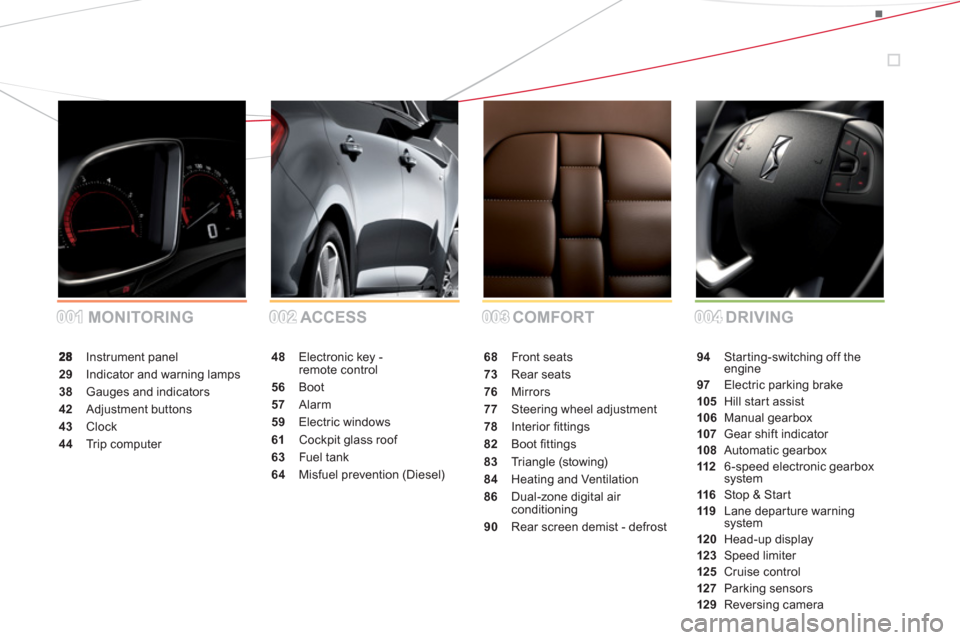
001001002002003003004004 COMFORT ACCESS MONITORINGDRIVING
Instrument panel
29 Indicator and warning lamps
38 Gauges and indicators
42 Adjustment buttons
43 Clock
44Tr i p c o m p u ter
48Electronic key -remote control
56 Boot
57 Alarm
59 Electric windows
61 Cockpit glass roof
63 Fuel tank
64 Misfuel prevention (Diesel)
68 Front seats
73 Rear seats
76Mirrors
77 Steering wheel adjustment
78 Interior fi ttings
82Boot fi ttings
83Tr i a ngle (stowing)
84Heating and Ventilation
86 Dual-zone digital air conditioning
90 Rear screen demist - defrost
94 Starting-switching off theengine
97Electric parking brake
105 Hill start assist
106 Manual gearbox
107 Gear shift indicator
10
8Automatic gearbox
112 6 -speed electronic gearboxsystem
116 Stop & Start
119Lane departure warning system
120 Head-up display
123 Speed limiter
125 Cruise control
127 Parking sensors
129Reversing camera
Page 7 of 348
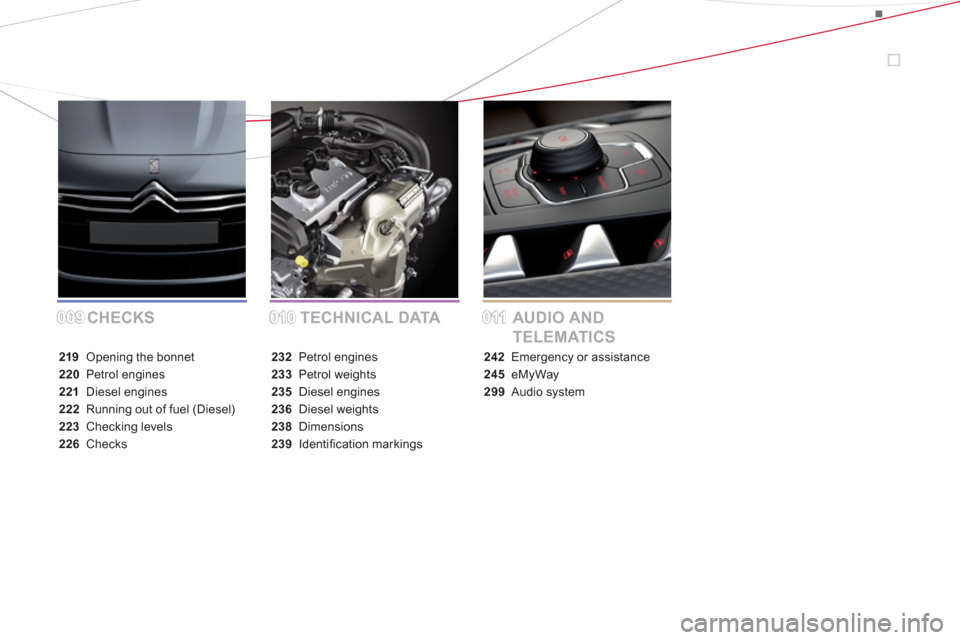
009009010010011011CHECKS TECHNICAL DATA AUDIO AND
TELEMATICS
219 Opening the bonnet
220 Petrol engines
221Diesel engines
222Running out of fuel (Diesel)
223Checking levels
226 Checks
232Petrol engines
233Petrol weights
235 Diesel engines
236 Diesel weights
238Dimensions
239Identifi cation markings
242 Emergency or assistance
245eMyWay
299Audio system
Page 10 of 348
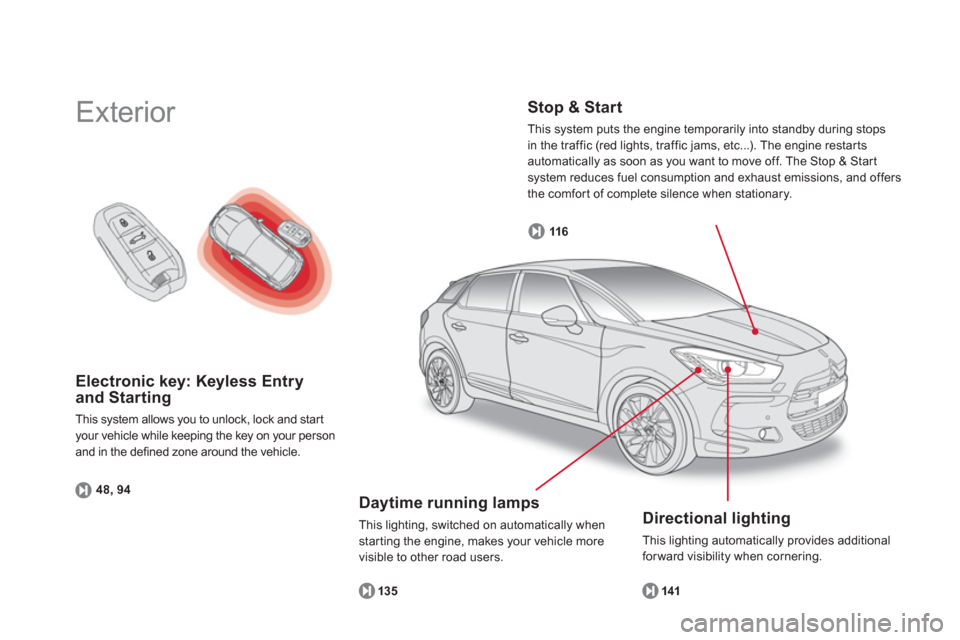
Electronic key: Keyless Entryand Starting
This system allows you to unlock, lock and star t
your vehicle while keeping the key on your person and in the defined zone around the vehicle.
48, 94
Exterior
Stop & Start
This system puts the engine temporarily into standby during stops
in the traffic (red lights, traffic jams, etc...). The engine restarts
automatically as soon as you want to move off. The Stop & Start
system reduces fuel consumption and exhaust emissions, and offers
the comfor t of complete silence when stationary.
116
Directional lighting
This lighting automatically provides additional forward visibility when cornering.
14
1
Daytime running lamps
This lighting, switched on automatically when
starting the engine, makes your vehicle more
visible to other road users.
135
Page 13 of 348
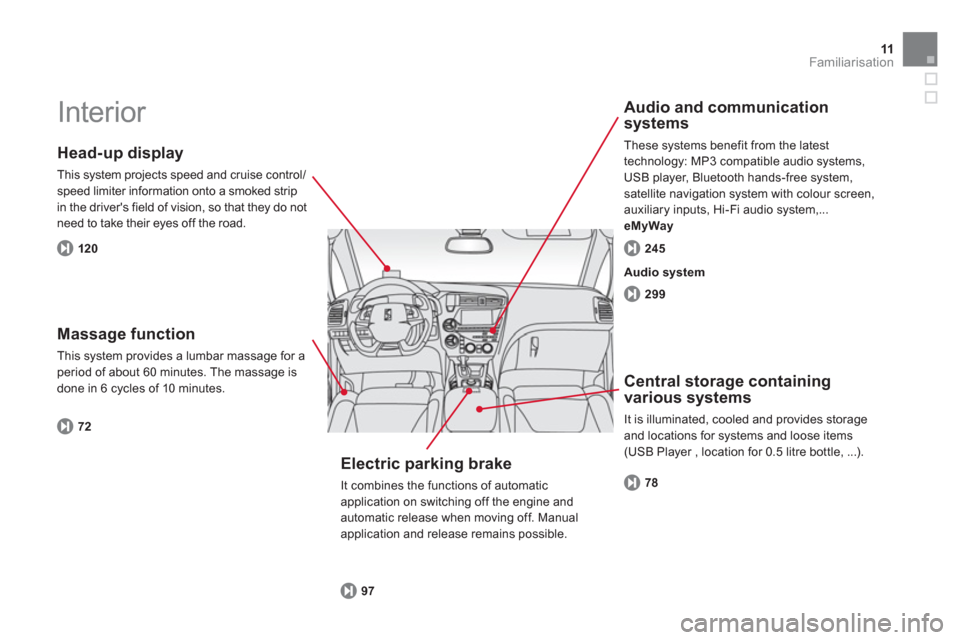
11Familiarisation
Interior
Head-up display
This system projects speed and cruise control/speed limiter information onto a smoked strip
in the driver's field of vision, so that they do not need to take their eyes off the road.
Central storage containing
various systems
It is illuminated, cooled and provides storage
and locations for s
ystems and loose items (USB Player , location for 0.5 litre bottle, ...).
Audio and communication
systems
These systems benefit from the latest
technology: MP3 compatible audio systems, USB player, Bluetooth hands-free system, satellite navigation system with colour screen,
auxiliary inputs, Hi-Fi audio system,...
eMyWay
120
7
8
299
245
Audio system
Massage function
This system provides a lumbar massage for aperiod of about 60 minutes. The massage is
done in 6 cycles of 10 minutes.
72
Electric parking brake
It combines the functions of automatic application on switching off the engine and automatic release when moving off. Manual application and release remains possible.
97
Page 21 of 348
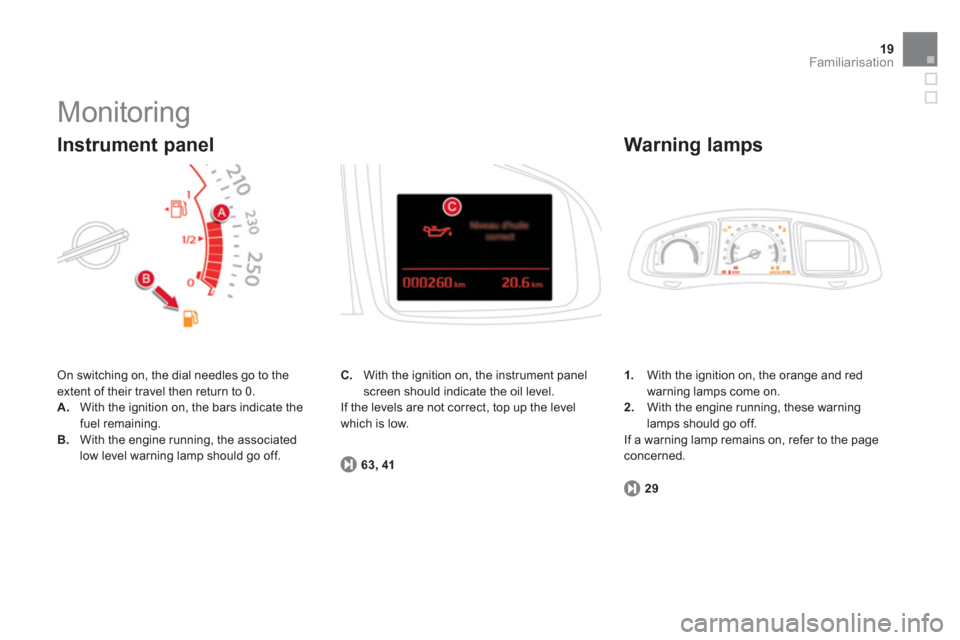
19Familiarisation
Monitoring
On switching on, the dial needles go to the extent of their travel then return to 0.
A.With the ignition on, the bars indicate the
fuel remaining.
B.With the engine running, the associated
low level warning lamp should go off.
Instrument panel
1.
With the ignition on, the orange and redwarning lamps come on. 2.With the engine running, these warninglamps should go off.
If a warning lamp remains on, refer to the page concerned.
Warning lamps
29
C.
With the ignition on, the instrument panelscreen should indicate the oil level.
If the levels are not correct, top up the level which is low.
63, 4
1
Page 23 of 348
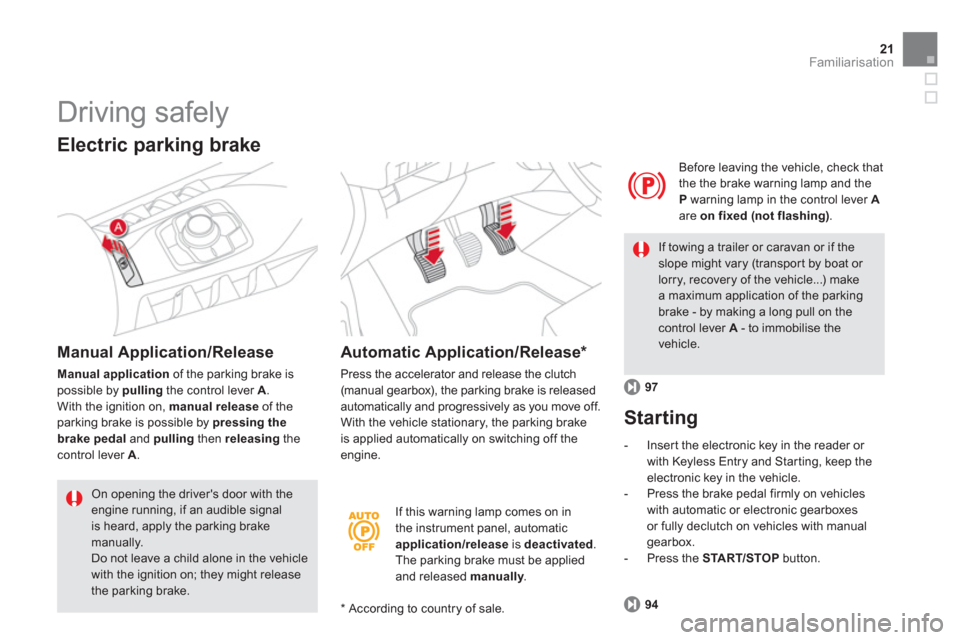
21Familiarisation
If this warning lamp comes on in
the instrument panel, automatic application/release is deactivated
.
The parking brake must be appliedand released manually.
y
Before leaving the vehicle, check that
the the brake warning lamp and theP warning lamp in the control lever Aare on fixed (not flashing).
97
If towing a trailer or caravan or if theslope might vary (transpor t by boat or lorry, recovery of the vehicle...) make a maximum application of the parking brake - by making a long pull on thecontrol lever A
- to immobilise thevehicle.
*
Accordin
g to country of sale.
Driving safely
Electric parking brake
Manual Application/Release
Manual application
of the parking brake is possible by pulling
the control lever A. With the ignition on, manual releaseof theparking brake is possible by pressing the brake pedal
and pulling
then releasing
the control lever A
.
On opening the driver's door with theengine running, if an audible signalis heard, apply the parking brake
manually. Do not leave a child alone in the vehicle with the ignition on; they might release the parking brake.
Automatic Application/Release *
Press the accelerator and release the clutch (manual gearbox), the parking brake is releasedautomatically and progressively as you move off.With the vehicle stationary, the parking brakeis applied automatically on switching off the
engine.
Starting
- Inser t the electronic key in the reader or
with Keyless Entry and Starting, keep the electronic key in the vehicle.
- Press the brake pedal firmly on vehicles
with automatic or electronic gearboxes
or
fully declutch on vehicles with manual
gearbox.
- Press the START/STOPbutton.
94
Page 24 of 348
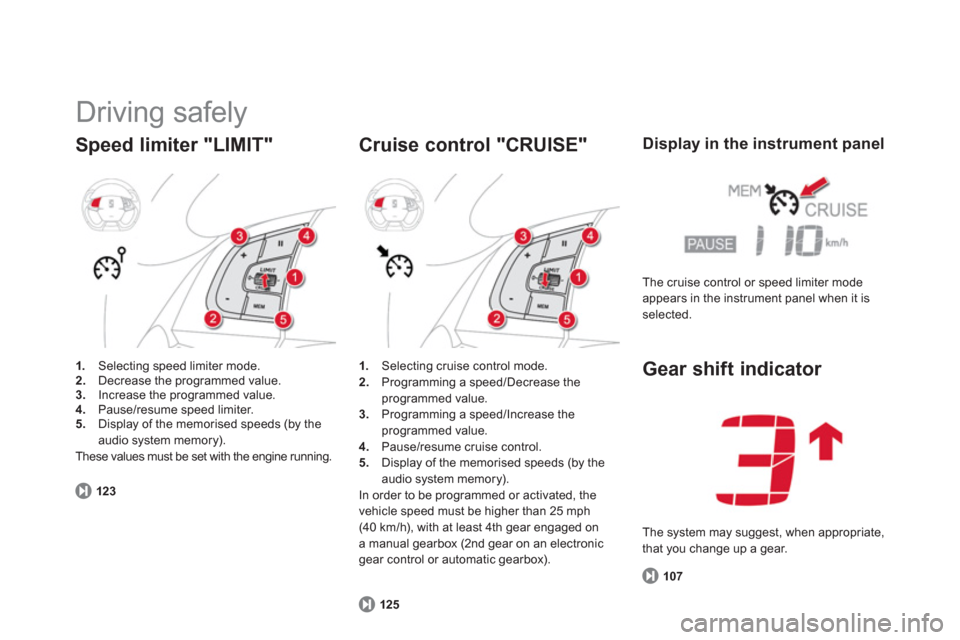
Driving safely
Speed limiter "LIMIT"
1.
Selecting speed limiter mode.2.
Decrease the programmed value.3.
Increase the programmed value.4.
Pause/resume speed limiter.5.
Display of the memorised speeds (by the audio system memory).
These values must be set with the engine running.
12
3
125
Cruise control "CRUISE"
1.Selecting cruise control mode.
2. Programming a speed/Decrease the
programmed value.3. Programming a speed/Increase the
programmed value.4.Pause/resume cruise control.
5.Display of the memorised speeds (by the
audio system memory).
In order to be programmed or activated, the
vehicle speed must be higher than 25 mph
(40 km/h), with at least 4th gear engaged on
a manual gearbox (2nd gear on an electronicgear control or automatic gearbox).
Display in the instrument panel
The cruise control or speed limiter mode
appears in the instrument panel when it isselected.
Gear shift indicator
107
The system may suggest, when appropriate,
that you change up a gear.
Page 25 of 348

23Familiarisation
Driving safely
Stop & Start
Going into engine STOP mode
116
The "ECO"warning lamp comes
on in the instrument panel and the
en
gine goes into standby; with theelectronic gearbox system andspeeds below 5 mph (8 km/h), press the brakepedal or put the gear lever in position N.
In certain circumstances, the STOP modemay not be available; the "ECO"warning lamp flashes for a few seconds, then goes off.
Going into engine START mode
Deactivation/Reactivation
117
11
7
The system is automatically reactivated every time the engine is star ted withthe STA R T/STOP button.
Before refuelling or doing anything under the bonnet, you must switchoff the ignition with the START/STOP button. Th
e "ECO"
warning lamp goes off
and the engine restar ts with theelectronic gearbox system:
- with the
gear lever in position A
or Mrelease the brake pedal,
- or with the gear lever in position N
andbrake pedal released, move the gear lever
to position A or M ,
- or engage reverse.
In certain circumstances, STA R T m o d e m ay beinvoked automatically; the "ECO"
warning lampflashes for a few seconds, then goes off. You can deactivate the s
ystem at any time bypressing the "ECO OFF"
button; the button's
warning lamp comes on.
Page 26 of 348
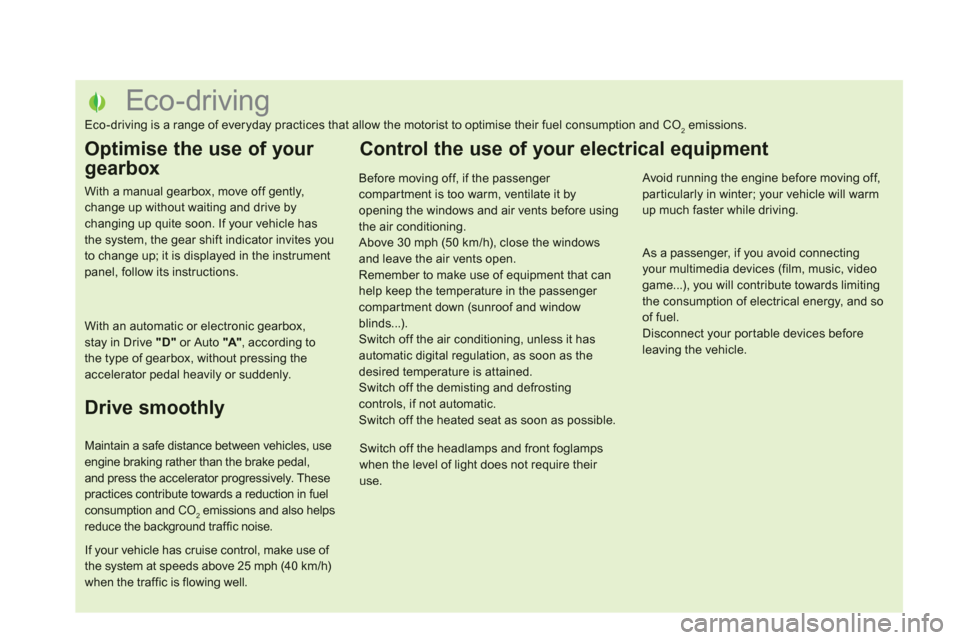
Eco-driving
Eco-driving is a range of everyday practices that allow the motorist to optimise their fuel consumption and CO2emissions.
Optimise the use of your
gearbox
With a manual gearbox, move off gently,change up without waiting and drive by changing up quite soon. If your vehicle has the system, the gear shift indicator invites youto change up; it is displayed in the instrumentpanel, follow its instructions.
With an automatic or electronic gearbox, stay in Drive "D"or Auto "A"
, according to the type of gearbox, without pressing theaccelerator pedal heavily or suddenly.
Drive smoothly
Maintain a safe distance between vehicles, useengine braking rather than the brake pedal,and press the accelerator progressively. These practices contribute towards a reduction in fuel consumption and CO2 emissions and also helpsreduce the background traffic noise.
If your vehicle has cruise control, make use of the system at speeds above 25 mph (40 km/h)when the traffic is flowing well.
Control the use of your electrical equipment
Before moving off, if the passenger compartment is too warm, ventilate it byopening the windows and air vents before using the air conditioning.
Above 30 mph (50 km/h), close the windows and leave the air vents open.
Remember to make use of equipment that canhelp keep the temperature in the passenger compartment down (sunroof and windowblinds...). Switch off the air conditioning, unless it has automatic digital regulation, as soon as thedesired temperature is attained.
Switch off the demisting and defrostingcontrols, if not automatic.
Switch off the heated seat as soon as possible.
Switch off the headlamps and front foglamps when the level of light does not require their use.
Avoid running the engine before moving off,particularly in winter; your vehicle will warmup much faster while driving.
As a passenger, if you avoid connecting your multimedia devices (film, music, videogame...), you will contribute towards limitingthe consumption of electrical energy, and soof fuel.
Disconnect your por table devices beforeleaving the vehicle.
Page 27 of 348
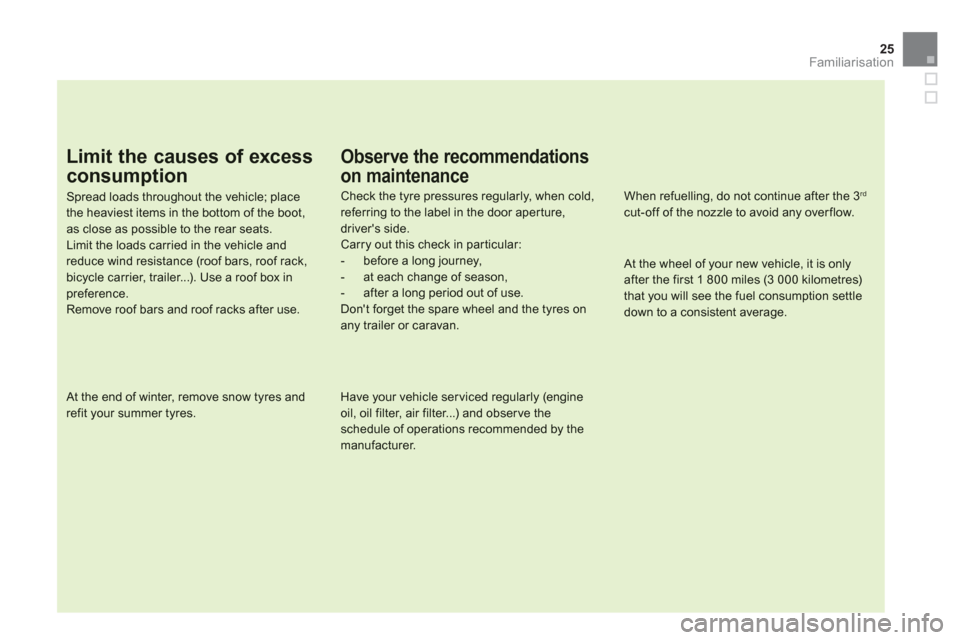
25
Familiarisation
Limit the causes of excess
consumption
Spread loads throughout the vehicle; place the heaviest items in the bottom of the boot,as close as possible to the rear seats.Limit the loads carried in the vehicle and reduce wind resistance (roof bars, roof rack, bicycle carrier, trailer...). Use a roof box inpreference.Remove roof bars and roof racks after use.
At the end of winter, remove snow tyres and refit your summer tyres.
Observe the recommendations
on maintenance
Check the tyre pressures regularly, when cold, referring to the label in the door aper ture, driver's side.Carry out this check in par ticular:- before a long journey,- at each change of season,- after a long period out of use. Don't forget the spare wheel and the tyres onany trailer or caravan.
Have your vehicle ser viced regularly (engine oil, oil filter, air filter...) and obser ve the schedule of operations recommended by the manufacturer.
When refuelling, do not continue after the 3 rd
cut-off of the nozzle to avoid any over flow.
At the wheel of your new vehicle, it is only after the first 1 800 miles (3 000 kilometres) that you will see the fuel consumption settledown to a consistent average.